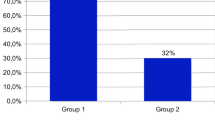Abstract
Introduction
The aim of this study was to examine the efficacy of transcutaneous electrical tibial nerve stimulation (TTNS) to treat urge urinary incontinence (UUI) in older women.
Material and methods
The study design was a randomized clinical trial conducted on 51 elderly women (>60 years) with UUI. All were treated with 12 weeks of bladder retraining and pelvic floor muscle exercises, and 25 were randomly selected to receive TTNS in addition to the standard therapy. The cases were evaluated at the baseline and after the end of therapy by 3-day bladder diary, quality of life questionnaires (QoL), and subjective response.
Results
Of the patients, 68.0% in TTNS group reported cure or improvement vs. 34.6% in the control group (P = 0.017). TTNS showed significant improvement in most areas of QoL and in UUI parameters when compared with the control group.
Conclusion
TTNS is efficacious to treat UUI in older women.

Similar content being viewed by others
References
Norton P, Brubaker L (2006) Urinary incontinence in women. The Lancet 367:57–67
Gibbs CF, Johnson TM, Ouslander JG (2007) Office management of geriatric urinary incontinence. Am J Med 120:211–220
Abrams P, Cardozo L, Fall M, Griffins D, Rosier P, Ulmsten U et al (2003) The standardization of terminology in lower urinary tract function: report from the standardization sub-committee of the International Continence Society. Urology 61:37–49
Borello FD, Burgio KL (2004) Nonsurgical treatment of urinary incontinence. Clin Obstet Gynecol 47:70–82
Cooperberg MR, Stoller ML (2005) Percutaneous neuromodulation. Urol Clin North Am 32:71–78
Skeil D, Thorpe AC (2001) Transcutaneous electrical nerve stimulation in the treatment of neurological patients with urinary symptoms. Br J Urol Int 88:899–908
Congregated Ruiz B, Pena Outeuriño XM, Campoy Martínez P, León Dueñas E, Leal López A (2004) Peripheral afferent nerve stimulation for treatment of lower urinary tract irritative symptoms. Eur Urol 45:65–69
Van Balken MR, Gisolf VV, KW VH, Kiemeney LA, Debruyne FM et al (2001) Posterior tibial nerve stimulation neuromodulative of the lower urinary tract dysfunction. J Urol 166:914–918
Amarenco G, Ismael SS, Even-Schneider A, Raibaut P, Wlodyka-Demaille S, Parratte B et al (2003) Urodynamic effect of acute transcutaneous posterior tibial nerve stimulation in overactive bladder. J Urol 169:2210–2215
Yamanishi T, Kama T, Yoshida KI (2008) Neuromodulation for the treatment of urinary incontinence. Int J Urol 15:665–672
Aslan A, Komurcu N, Beji NK, Yalcin O (2008) Bladder Training and kegel exercises for women with urinary complaints living in a rest home. Gerontology 54:224–231
Maciel AC (2006) Incontinência Urinária. In: Freitas EV, Py L, Cançado FAZ, Doll J, Gorzoni ML (eds) Tratado de Geriatria e Gerontologia. Guanabara Koogan, Rio de Janeiro, pp 723–732
DuBeau EC (2006) The aging lower urinary tract. J Urol (Suppl 175):11-15
Chen GD (2007) Pelvic floor dysfunction in aging women. Taiwan J Obstet Gynecol 46(4):374–378
DuBeau EC (2009) Therapeutic/pharmacologic approaches to urinary incontinence in older adults. Clin Pharm Ther 85(1):98–102
Subak LL, Wing R, West DS, Franklin F, Vittinghoff E, Creasman JM et al. (2009) Weight loss to treat urinary incontinence in overweight and obese women. N Engl J Med 360(5):481–490.
National Institute for Health and Clinical Excellence. The management of urinary incontinence in women. October 2006. Available at: www.nice.org.uk.
Vandoninck V, Van Balken MR, Finazzi Agro E, Petter F, Caltagirone C, Heesakkers JP et al (2003) Posterior tibial nerve stimulation in the treatment of urge incontinence. Neurourol Urodyn 22(1):17–23
Peters KM, MacDiarmid SA, Wooldridge LS, Leong AC, Shobeiri SA, Roner ES et al (2009) Randomized trial of percutaneous tibial nerve stimulation versus extended-release tolterodine: results from the overactive bladder innovative therapy trial. J Urol 182(3):1055–1061
Peters K, Carrico D, Burks F (2009) Validation of a sham therapy for percutaneous tibial nerve stimulation. Neurourol Urodyn 28:58
O’Reilly BA, Dwyer PL, Hawthorne G, Cleaver S, Thomas E, Rosamilia A et al (2004) Transdermal posterior tibial nerve laser therapy is not effective in women with insterstitial cystitis. J Urol 172:1780–1883
Conflicts of interest
None.
Author information
Authors and Affiliations
Corresponding author
Rights and permissions
About this article
Cite this article
Schreiner, L., dos Santos, T.G., Knorst, M.R. et al. Randomized trial of transcutaneous tibial nerve stimulation to treat urge urinary incontinence in older women. Int Urogynecol J 21, 1065–1070 (2010). https://doi.org/10.1007/s00192-010-1165-6
Received:
Accepted:
Published:
Issue Date:
DOI: https://doi.org/10.1007/s00192-010-1165-6




